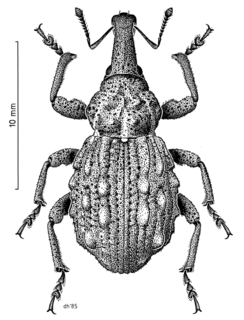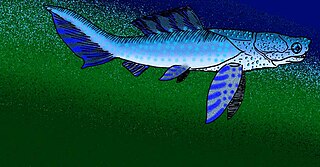
The red-rimmed melania, scientific name Melanoides tuberculata, is a species of freshwater snail with an operculum, a parthenogenetic, aquatic gastropod mollusk in the family Thiaridae.

The New Zealand long-tailed bat, also known as the long-tailed wattled bat or pekapeka-tou-roa (Māori), is one of 15 species of bats in the genus Chalinolobus variously known as "pied bats", "wattled bats" or "long-tailed bats". It is one of the two surviving bat species endemic to New Zealand, but is closely related to five other wattled or lobe-lipped bats in Australia and elsewhere. It was named the winner in the 2021 Bird of the Year competition in New Zealand, despite not being a bird.

Hadramphus tuberculatus is a rare weevil endemic to Canterbury in the South Island of New Zealand. It was thought to be extinct in 1922 but was rediscovered in 2004.
Rhacophorus tuberculatus is a species of frog in the family Rhacophoridae found in eastern and northeastern India and southeastern Tibet, China. It is known from tropical moist forests and bamboo forests. Breeding has been observed from bushes near to small forest ponds. It may hide in bamboo stems during the day. The species is threatened by habitat loss.

Vanderhaege's toad-headed turtle is a species of turtle in the family Chelidae. The species is endemic to South America.

The Vanikoro flying fox, also known locally as basapine, is a species of bat in the family Pteropodidae. It has only been found in the Vanikoro island group located in the southern Solomon Islands. The species as a whole was originally known from just a few specimens collected sometime before 1930 but following surveys conducted on the island in the early 1990s did not detect this species again causing the Vanikoro flying fox to be listed as extinct. However, the species was rediscovered by a survey conducted in late 2014 which indicated a population in the high hundreds or low thousands and reported all observations.

Haematopinus is a genus of insects in the superfamily Anoplura, the sucking lice. It is the only genus in the family Haematopinidae, known commonly as the ungulate lice. All known species are of importance in veterinary medicine. These lice are some of the most economically important ectoparasites of domestic animals. Species infest many domesticated and wild large mammals, including cattle, horses, donkeys, swine, water buffalo, African buffalo, antelope, zebra, deer, and camels. The species Haematopinus tuberculatus has great importance in the water buffalo breading, since this louse is specific to buffaloes, being the main ectoparasite of the species, with important sanitary and economic burden. The Haematopinus tuberculatus is suspected to be involved in the transmission of diseases, such as anaplasmosis. The parasites are found infesting buffaloes in greater concentrations around the ears, base of horns, side of the neck, around the scrotum or udder, and especially at the tip of the tail.

Amaranthus tuberculatus, commonly known as roughfruit amaranth, rough-fruited water-hemp, tall waterhemp, or common waterhemp, is a species of flowering plant. It is a summer annual broadleaf with a germination period that lasts several months. Tall waterhemp has been reported as a weed in 40 of 50 U.S. states.

Retodus is an extinct genus of prehistoric lungfish found in Cretaceous-aged freshwater strata of Egypt, Algeria and Niger. The type species, R. tuberculatus, was named in 2006. It was originally named as a species of Ceratodus and Neoceratodus in 1963.

Mesoclemmys is a South American genus of turtle in the Chelidae family.
Ologamasidae is a family of mites in the order Mesostigmata. There are more than 40 genera and 470 described species in Ologamasidae.
Euryparasitidae is a family of mites in the order Mesostigmata.
Acugamasus is a genus of mites in the family Ologamasidae. There are about 19 described species in Acugamasus.
Acugamasus montanus is a species of mite in the family Ologamasidae. It is found in Europe.
Acugamasus nepotulus is a species of mite in the family Ologamasidae.
Acugamasus plumitergus is a species of mite in the family Ologamasidae.

Simosteus tuberculatus is a small arthrodire placoderm from the Gogo Formation of Western Australia. Unlike other members of the arthrodire family Camuropiscidae, S. tuberculatus had a short, snub-nose, as directly implied by the translation of its generic name, "snub-nosed bone." Although S. tuberculatus lacks the characteristic elongated nose, it shares other diagnostic features of camuropiscids, such as cheekplates sutured to the cranium.

Rhinosteus is a genus of small to medium selenosteid arthrodire placoderms known from the Upper Frasnian Kellwasserkalk facies of Late Devonian Germany and Morocco.

Helodermoides is an extinct genus of anguid lizards from the Oligocene of North America. The genus is monotypic, including only the species Helodermoides tuberculatus. Helodermoides belongs to an extinct subfamily of anguids called Glyptosaurinae. In addition to many fragmentary bones, several complete skeletons of Helodermoides are known. Like other glyptosaurines, Helodermoides was covered in small scale-like bones called osteoderms. The osteoderms covering its skull are hexagonal, tightly interlocking, raised, and rounded.
Pseudarmadillo tuberculatus is an extinct species of isopod in the family Delatorreiidae known from a series of possibly Miocene fossils found on Hispaniola. At the time of description P. tuberculatus was one of two Pseudarmadillo species known from the fossil record and one of only two from Hispaniola.











